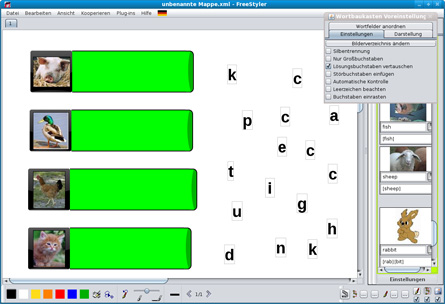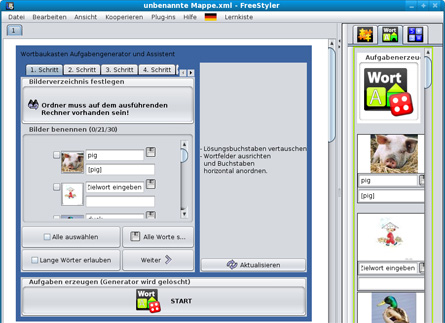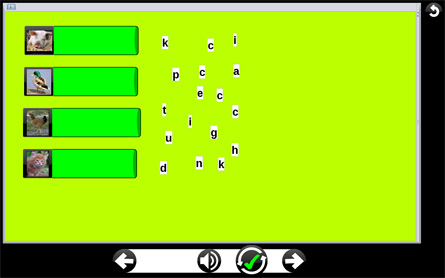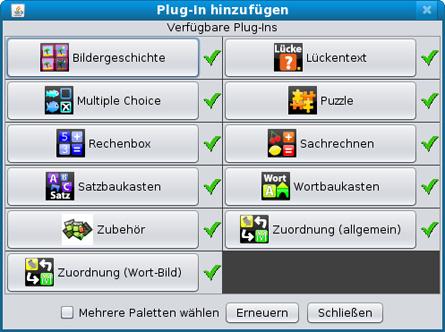Duration
February 2006 - December 2008
Funding
Landesstiftung / Medienoffensive Schule II
Homepage
http://www.lmmp-bw.de/
Description
There is no doubt that computers are capable to support pupils with learning
disabilities in learning. Nevertheless, we observe a lack of professional learning
software for this target group. On the one hand, there are products designed
by special education teachers with a high level of instructional design but
at a low technical level. On the other hand there are loads of commercial products
with absence of any instructional quality. In our project LMMP we wanted to
overcome these problems by developing a learning platform for this special target
group in an interdisciplinary group based on participatory design principles.
Our main objective was to integrate the computer into daily teaching and learning
practice supporting pupils in existing learning procedures without mandatory
change of well suited pedagogic methods. Therefore we used the complementary
expertise of teachers for children with cognitive disability, computer scientists
and psychologists. We developed ten different modules - e.g. for visual apperception,
learning reading and writing and calculating. To provide easy access to the
generated tasks a special desktop for the pupils has been developed.
First experiences of teachers and pupils using the software have been very positive.
We observed that the modules could be adapted easily by the teacher to meet
the different needs of the pupils. Hence, the pupils were very motivated and
worked with the software effectively.
Teacher tool
With the teacher tool the teachers can create new tasks or change and adapt
already existing tasks. The latter allows reusing formerly created tasks or
interchanging tasks with colleagues and adapting them to local needs. Figure
1 shows the draft for a writing tasks created with the teacher tool.
Figure 1: Creating a task with the teacher tool

For the creation of more complex tasks wizards were implemented to assist the
teacher (figure 2). Apart from using the wizard for experts it is still possible
to create even complex tasks manually or change tasks later.
Figure 2: Creating a task using a wizard

The pupils desktop
To facilitate easy access to the personal data and tasks and to focus the attention
a special desktop has been implemented. Thereto further experiences from other
projects could be incorporated. To ensure that the desktop meets the needs of
the special target group of pupils with cognitive disabilities and learning
difficulties it has undergone a special design process. In cooperation with
Wertewerk (http://www.wertewerk.org), a local company specialised to barrier
free web-design and relating questions, we implemented not only a special customised
layout but also elaborated data and information flow processes.
Figure 3: Writing task opened on the pupils desktop

Short description of modules
Figure 4: Selection of different modules

Focus "cognitive disabled"
- Picture Story: here, a sequence of pictures and images can be composed
to a multi-page story enriched with text and sound components.
- Jigsaw puzzle: user-defined images can be used to create jigsaw puzzle tasks.
Optional the number and size of the pieces can be adjusted and different support
mechanisms can be activated.
- Calculating tasks: addition and subtraction tasks for the number range between
1 and 20 can be created. The tasks are represented by text and visualised
with icons. The task can be solved either by typing the result in numbers,
using drag&drop or in a mixed form.
- Word kit: the teacher can assign words to images and then the pupils get
either syllables or single letters which have to be ordered in a writing field.
- Assignment (universal): the main focus of this module is to provide assignment
tasks with pictures. But not limited to this it is also possible to create
assignment tasks multi representational tasks with different objects such
as sound, voice-recording or text.
- Assignment (word-picture): with this module the teacher can create simple
assignment tasks between one word and one picture.
Focus "learning difficulties"
- Cloze: with this module the teacher can create a cloze where pupils have
to fill in single words, syllables or endings by drag&drop operations.
- Multiple-choice: the teacher can easily create a multi page multiple-choice
test by using a simple wizard. At the end of the task the pupils get immediate
feedback.
- Written math tasks: here the teacher can create written math tasks using
different representations.
- Sentence kit: analogue to the word kit here the teacher can assotiate sentences
with images. The pupils have to bring the words into order to form a sentence
in a writing space.
For more information visit
http://www.lernkiste-bw.de
Cooperations
- Kultusministerium Baden-Württemberg (Medienoffensive Schule II)
- Kirnbachschule, Tübingen
- Wertewerk, Tübingen
Publications
- A. Lingnau & A. Harrer (2008) . Designing Software for Pupils with
Special Needs: Analysis of an Example for Complementary Action Design. In
Pierre Dillenbourg & Marcus Specht (Eds.), Times of Convergence: Technologies
Accross Learning Contexts. 3rd European Conference on Technology Enhanced
Learning, EC-TEL 2008. Proceedings. Lecture Notes in Computer Science
5192 (pp.245-249 ). Berlin: Springer.
- A. Lingnau (2008) . A software design approach for pupils with special needs.
In Paloma Diaz, Kinshuk, Ignacio Aedo, Eduardo Mora (Eds.), Proceedings
of 8th IEEE International Conference on Advanced Learning Technologies. IEEE
Computer Society (pp. 128-130). Los Alamitos, CA.
- A. Lingnau & P. Zentel (2008). A computer supported learning environment
to support pupils with cognitive disabilities and their teachers. Proceedings
of International Conference of the Learning Science (ICLS), Utrecht,
2008.
- Lingnau, A., Zentel, P., & Cress, U. (2007). Fostering collaborative
problem solving for pupils with cognitive disabilities. In C. A. Chinn, G.
Erkens, & S. Puntambekar (Eds.), Proceedings of the Computer Supported
Collaborative Learning Conference 2007: International Society of the Learning
Sciences (pp. 447-449). New Brunswick, NJ: International Society of the
Learning Sciences.
- P. Zentel, A. Lingnau & E. Ratzke (2007). A multi-media software environment
for children with cognitive disability. In R. Carlsen, K. McFerrin, J. Price,
R. Weber, & D. A. Willis (Eds.), Proceedings of the Society for Information
Technology and Teacher Education International Conference 2007 (pp. 3668-3673).
Chesapeake, VA: AACE.
- Lingnau, A., Zentel, P., & Mästle, T. (2007). A computer-supported
learning platform for pupils with cognitive disabilities. In Proceedings
of the German E-Science Conference 2007. URL:
http://edoc.mpg.de/316636.